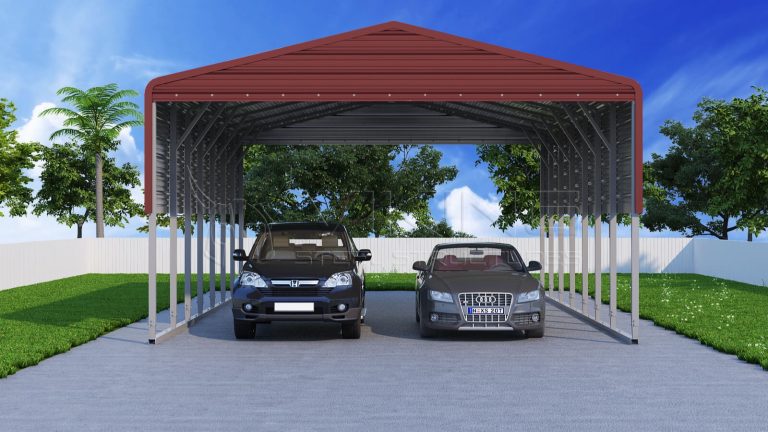Essential Tips for Waterproofing Your Metal Building

Did you know that 93% of water damage would have been prevented if a leak detection system or shutdown system had been installed? Not just that, 8% of the water damage to the house is due to bad weather.a
Water, being one of the crucial sources of life, often causes damage when not taken care of. So, to prevent any mishap, let’s see some tips and techniques that you can implement to safeguard your home from water damage.
11 CRUCIAL TIPS FOR WATERPROOFING METAL BUILDINGS
For Waterproofing Steel Buildings Pre-Installation
1. Roofing Style
One problem is that you can’t reach your roof very often, and it is harder to clean. So, if your roof collects debris and water, they will scratch the metal surface, removing the protective layer that saves it from rusting. This will trigger corrosion.
We recommend getting a vertical steel roof for your metal building. The reason is simple – a vertical corrugated roof allows water and other debris to slide down quickly, leaving no room for a collection of water on the roof.
2. Use High-Quality Steel
When you use high-quality galvanized steel from a reputed metal builder, it gives certainty that your steel building will last long. That’s why Viking Steel Structures provides certified galvanized steel directly from the manufacturing facility at a reasonable price.
3. Seal Exterior Walls
Whether it is melting snow, the wind-carrying water droplets, or heavy rain, all bring along moisture content with them. That’s not good for metal structures. The moisture can enter from leaks, cracks, or poorly insulated corners. This will lead to moisture built-up over time.
So, what would happen? Well, you see…when exposed to moisture for a longer time, metal may start to rust. Moreover, molds and mildew may develop. That is not good for your mental structure or for your health.
So, seal them promptly. You can use caulking, glazing, or other sealant to fix it.
4. Paint
Although you can paint your metal structure after installation, you must re-paint your building every 5 or 10 years to ensure the coating protects your structure. But you can’t just use any paint here. The best thing to do will be to apply a thick coat of waterproof paint that is meant for metals.
5. Ensure That All Screw & Bolts Are Properly Tighten
Any loose screws or bolts can lead to water leakage. If water collects in the gap or hole for a longer period of time, it will start to erode. To prevent this, ensure that a professional team installs your steel building.
We offer colored screws to match the aesthetics of your building. That’s right! Now, we also have a 3D building designer tool; you can use it to custom design your building and visualize it on your property. So, check them out.
For Waterproofing Metal Building After Installation
6. Humidity Level
You can either install a de-humidifier or have air vents to regular the air circulation inside your steel building. This will keep the humidity level low. You can either have passive vents (that do not require electricity) or active ventilation for air circulation.
7. Weather Stripping
If you find any cracks developing near doors or window frames or in your foundation, seal them as soon as you find them to ensure that your building remains safe from moisture entry. This will also ensure that small insects like ants cannot enter the structure.
8. Clean Surrounding Area
Not only is standing water the breeding ground for insects that carry malaria or dengue, but it is also a clear sign that your drainage system is not functioning properly.
9. Flashing
It decreases water entry from opening areas like chimneys, vent pipes, walls, windows, doors, etc. This will reduce indoor mold development issues. Generally, metal flashing materials are lead, aluminum, copper, zinc, and some other materials.
10. Insulator
An insulator reduces condensation and moisture built up in your metal structure. The best choice here would be to opt for a continuous insulator such as rigid foam, mineral wool, cork, etc. This will protect your building from water.
11. Vapor Retardant
This is another method for waterproofing metal buildings. It helps protect from condensation by reducing air leakage and preventing moisture from entering the building. While choosing vapor retardant, you must consider its permeability, workability, and external temperature conditions during installation.
Without a good vapor retardant, moisture will condense on metal cladding and may end up saturating your insulation.
Some Other Tips That Will Help You With Waterproofing Metal Buildings
- Ensure that your building is clean from inside and outside.
- You must check your roof for any leakage or debris collected, such as twigs, dried leaves, etc.
- Regularly inspect your metal structure. It does not have to be a rigorous inspection on a daily basis; however, once a month would be advisable, especially if you live in an area with frequent rain.
- If you see any rust, fix it promptly. You can use sandpaper to remove rust and paint the area.
- And finally, keep a check on your HAVC system. If you notice any leakage in the water pipe, fix it immediately to avoid chances of corrosion.
- If you live in an area with frequent rain, ensure that your gutter and downspout are clean so that water can pass easily.
- If you see standing water hours after rain, that is a clear sign that your drainage system is not working correctly.
Get Your Waterproof Metal Building From Viking Steel Structures
Discover the best solution for rain and adverse weather from Viking Steel Structures. We deliver certified high-quality steel buildings with multiple color options to choose from. We have designed steel buildings that can withstand extreme rain, snow, and wind. To get your custom steel structure, call us today at 877-801-3263.

Looking for a metal building that fits your needs?
